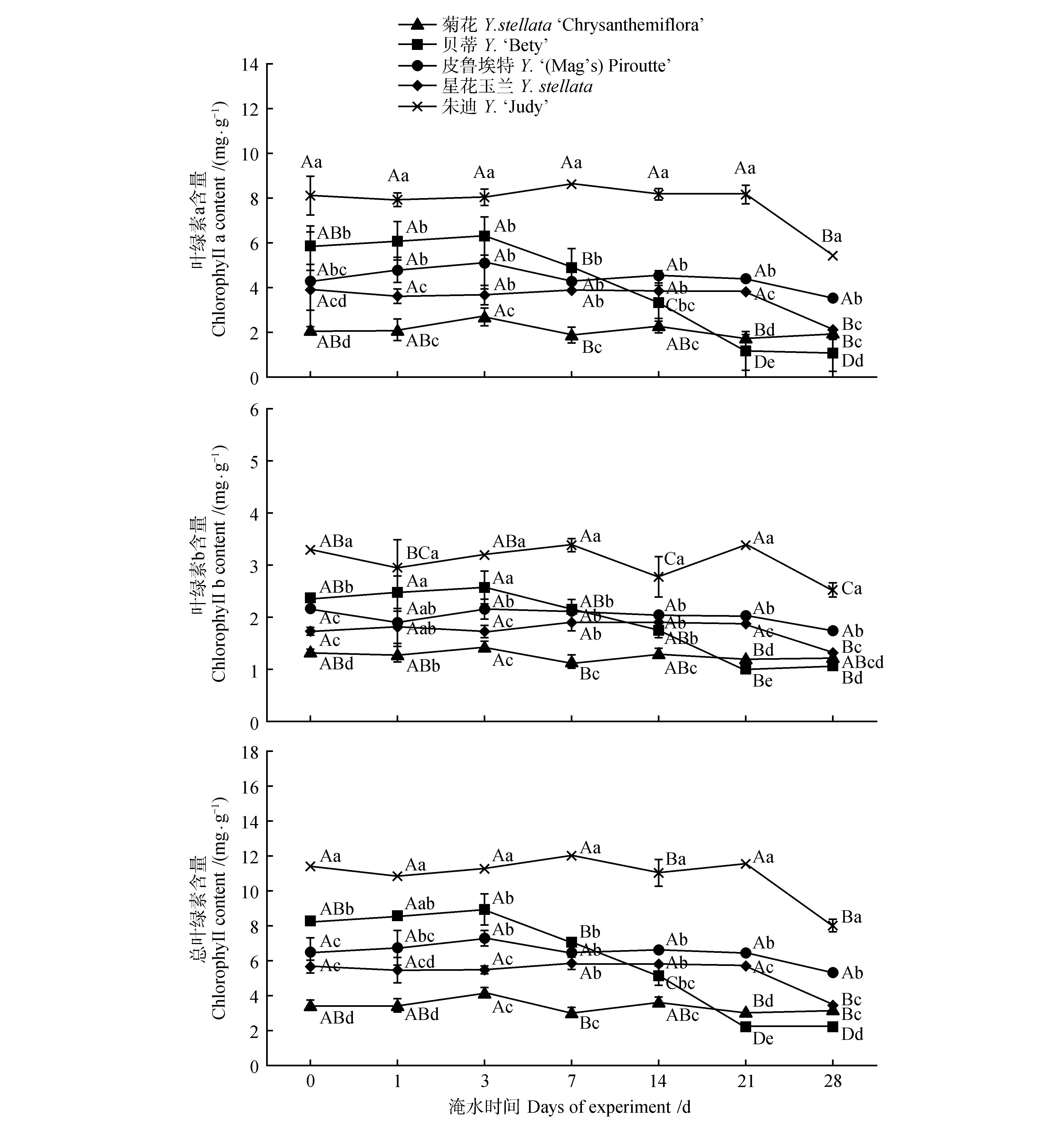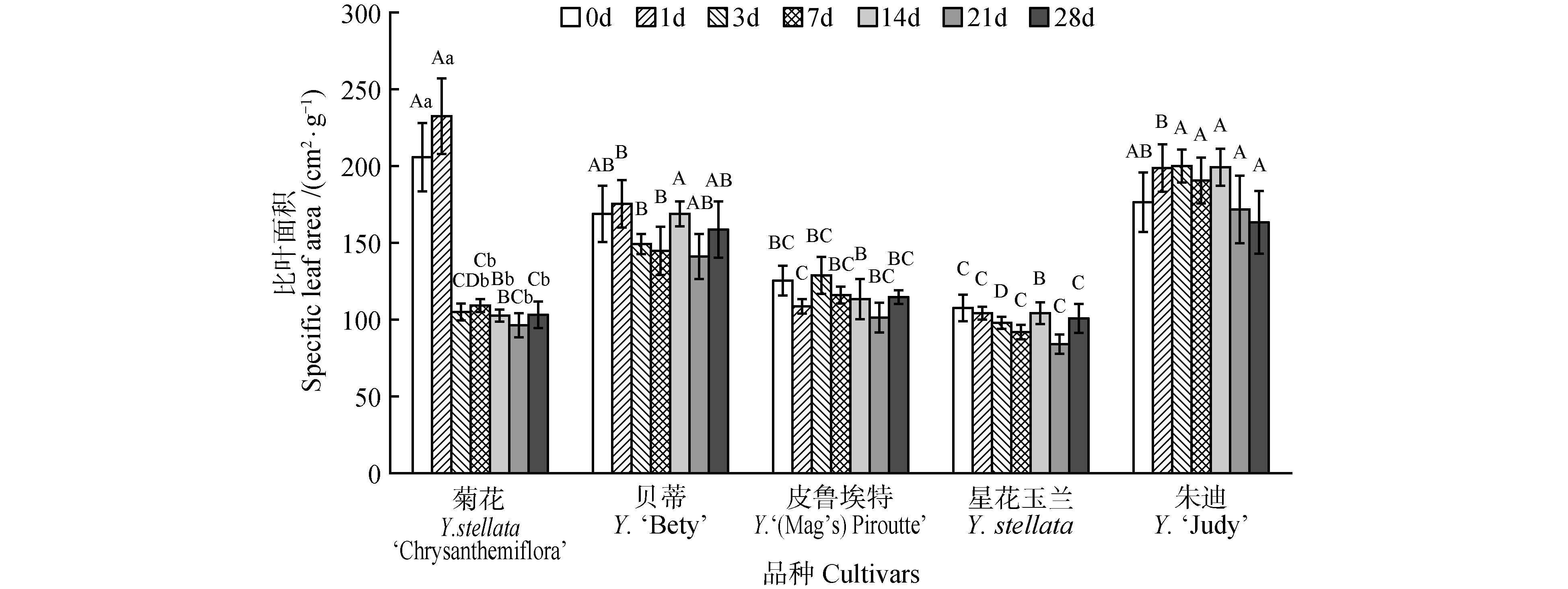Bulletin of Botanical Research ›› 2022, Vol. 42 ›› Issue (3): 483-491.doi: 10.7525/j.issn.1673-5102.2022.03.018
• Physiology and Ecology • Previous Articles Next Articles
Xiwu DU1,2, Jun QIN2,3, Kang YE2,3, Yonghong HU2,3, Yiwei TAO1, Yongzheng PENG1, Yanxiang SHEN1, Yan LIANG1, Li ZENG1( )
)
Received:2020-12-17
Online:2022-05-20
Published:2022-05-20
Contact:
Li ZENG
E-mail:zljs@sjtu.edu.cn
About author:DU Xiwu(1994—),male,master,innovation of ornamental plant germplasm resources.
Supported by:CLC Number:
Xiwu DU, Jun QIN, Kang YE, Yonghong HU, Yiwei TAO, Yongzheng PENG, Yanxiang SHEN, Yan LIANG, Li ZENG. Effects of Flooding Stress on Photosynthetic Characteristics of Yulania stellata and Its Cultivars[J]. Bulletin of Botanical Research, 2022, 42(3): 483-491.
Add to citation manager EndNote|Ris|BibTeX
URL: https://bbr.nefu.edu.cn/EN/10.7525/j.issn.1673-5102.2022.03.018

Fig.1
Effect of flooding stress on the chlorophy Ⅱ content of Y. stellata and its cultivarsThe different lowercase letters indicate significant difference between different cultivars at the same time treatment(P<0.05);Different uppercase letters mean that there is significant difference between different days treatment of the same cultivar(P<0.05)


Fig.2
Effect of flooding stress on the leaf area of Y.stellata and its cultivarsThe different uppercase letters indicate significant difference between different cultivars at the same time treatment(P<0.05);Different lowercase letters mean that there is significant difference between different days treatment of the same cultivar(P<0.05);The same as below

Table 1
Characteristic parameters of light response curve of Y. stellata and its cultivars under flooding stress
品种 Cultivars | 处理 Treatment | 最大净光合速率 Pnmax /(μmol·m-2·s-1) | 表观量子效率 Φ /(mol·mol-1) | 光饱和点 LSP /(μmol·m-2·s-1) | 光补偿点 LCP /(μmol·m-2·s-1) | 暗呼吸速率 Rd /(μmol·m-2·s-1) |
|---|---|---|---|---|---|---|
菊花 Y. stellata ‘Chrysanthemiflora’ | 对照CK | 12.73±0.14A | 0.065±0.003BC | 493.08±5.22B | 13.89±0.08CD | 0.90±0.04CD |
| 淹水处理FL | 10.01±0.08B | 0.053±0.003CD | 308.48±2.45E | 18.60±2.13BC | 0.99±0.11BC | |
贝蒂 Y. ‘Bety’ | 对照CK | 7.06±0.09E | 0.052±0.005CD | 528.44±8.17A | 17.27±0.89BC | 0.89±0.14CD |
| 淹水处理FL | 3.91±0.4G | 0.038±0.021D | 191.18±17.42G | 11.88±3.97D | 0.39±0.07E | |
皮鲁埃特 Y. ‘(Mag’s)Piroutte’ | 对照CK | 12.76±0.19A | 0.060±0.005BCD | 417.06±5.98C | 11.64±1.89D | 0.70±0.18D |
| 淹水处理FL | 8.99±0.04C | 0.065±0.003BC | 347.58±1.71D | 10.92±0.67D | 0.71±0.08D | |
星花玉兰 Y. stellata | 对照CK | 8.96±0.85C | 0.081±0.033B | 325.44±30.51DE | 11.26±5.51D | 0.88±0.28CD |
| 淹水处理FL | 5.87±0.05F | 0.047±0.003CD | 301.56±2.62E | 19.59±1.28B | 0.71±0.07D | |
朱迪 Y. ‘Judy’ | 对照CK | 8.09±0.25D | 0.055±0.032CD | 321.95±9.02E | 25.16±3.24A | 1.38±0.05A |
| 淹水处理FL | 7.06±0.01E | 0.107±0.001A | 256.46±0.19F | 11.21±0.03D | 1.20±0.02AB |
| 1 | 杜习武,叶康,秦俊.星花玉兰及其品种的光响应模型筛选[J].西部林业科学,2019,48(4):132-136. |
| DU X W, YE K, QIN J.Selection of photosynthesis light response model of Yulania stellata and its varieties[J].Journal of West China Forestry Science,2019,48(4):132-136. | |
| 2 | 安渊,陈凡毅,王俊,等.半秋眠和非秋眠紫花苜蓿品种耐涝性能研究[J].中国草地,2004,26(4):31-36. |
| AN Y, CHEN F Y, WANG J,et al.Studies on waterlogging tolerance of semi-fall and non-Fall dormant alfalfa cultivars[J].Grassland of China,2004,26(4):31-36. | |
| 3 | 潘澜,薛立.植物淹水胁迫的生理学机制研究进展[J].生态学杂志,2012,31(10):2662-2672. |
| PAN L, XUE L.Plant physiological mechanisms in adapting to waterlogging stress:a review[J].Chinese Journal of Ecology,2012,31(10):2662-2672. | |
| 4 | 王萍,胡永红,王丽勉,等.观赏植物耐涝性鉴定指标的种类及其评价方法[J].北方园艺,2007(11):78-81. |
| WANG P, HU Y H, WANG L M,et al.Kinds of identification index and the evaluation means of plant submergence endurance[J].Northern Horticulture,2007(11):78-81. | |
| 5 | MCFARLANE N M, CIAVARELLA T A, SMITH K F.The effects of waterlogging on growth,photosynthesis and biomass allocation in perennial ryegrass(Lolium perenne L.) genotypes with contrasting root development[J].The Journal of Agricultural Science,2003,141(2):241-248. |
| 6 | BANSAL R, SRIVASTAVA J P.Effect of waterlogging on photosynthetic and biochemical parameters in pigeonpea[J].Russian Journal of Plant Physiology,2015,62(3):322-327. |
| 7 | 章毅,蔡建国,孙欧文,等.水淹胁迫下绣球光合响应机制的研究[J].核农学报,2019,33(4):808-815. |
| ZHANG Y, CAI J G, SUN O W,et al.Research on photosynthetic responses mechanisms of Hydrangea macrophylla under waterlogging stress[J].Journal of Nuclear Agricultural Sciences,2019,33(4):808-815. | |
| 8 | 胡燕莉,袁军辉,胡永红.水淹和恢复对凤丹光合特性和根系活力的影响[J].西北植物学报,2017,37(8):1586-1594. |
| HU Y L, YUAN J H, HU Y H.Effects of waterlogging and recovery on the photosynthetic characteristics and root activity of Paeonia ostia [J].Acta Botanica Boreali-occidentalia Sinica,2017,37(8):1586-1594. | |
| 9 | SETSUKO S, NAGAMITSU T, TOMARU N.Pollen flow and effects of population structure on selfing rates and female and male reproductive success in fragmented Magnolia stellata populations[J].BMC Ecology,2013,13(1):10. |
| 10 | KISANUKI H, OGURO H, NAKAI A,et al.The soil seed bank of the threatened plant Magnolia stellata is subordinate to the emergence of current-year seedlings[J].Journal of Forest Research,2008,13(2):143-146. |
| 11 | TAMAKI I, NOMURA K, NOMURA R,et al.Seedling survival and growth during the 2 years following seed germination of Magnolia stellata,a threatened subcanopy tree,after clearcutting[J].Journal of Forest Research,2015,20(4):415-419. |
| 12 | TAMAKI I, NOMURA K, NOMURA R,et al.Evaluation of a field experiment for the conservation of a Magnolia stellata stand using clear-cutting[J].Landscape and Ecological Engineering,2018,14(2):269-276. |
| 13 | UENO S, SETSUKO S, KAWAHARA T,et al.Genetic diversity and differentiation of the endangered Japanese endemic tree Magnolia stellata using nuclear and chloroplast microsatellite markers[J].Conservation Genetics,2005,6(4):563-574. |
| 14 | 王晶,严丹峰,王亚玲.5种木兰科(Magnoliaceae)植物的耐涝性研究[J].广东园林,2019,41(1):19-22. |
| WANG J, YAN D F, WANG Y L.Studies on waterlogging tolerance of five Magnoliaceae plants[J].Guangdong Landscape Architecture,2019,41(1):19-22. | |
| 15 | 徐亚婷.水分胁迫下茶树抗性机理的研究[D].南京:南京农业大学,2016. |
| XU Y T.The study on resistance to water stress in tea plant(Camellia sinensisi)[D].Nanjing:Nanjing Agricultural University,2016. | |
| 16 | 叶子飘,于强.光合作用光响应模型的比较[J].植物生态学报,2008,32(6):1356-1361. |
| YE Z P, YU Q.Comparison of new and several classical models of photosynthesis in response to irradiance[J].Journal of Plant Ecology,2008,32(6):1356-1361. | |
| 17 | 胡耀升,么旭阳,刘艳红.长白山森林不同演替阶段比叶面积及其影响因子[J].生态学报,2015,35(5):1480-1487. |
| HU Y S, YAO X Y, LIU Y H.Specific leaf area and its influencing factors of forests at different succession stages in Changbai Mountains[J].Acta Ecologica Sinica,2015,35(5):1480-1487. | |
| 18 | 杨鹏,胥晓.淹水胁迫对青杨雌雄幼苗生理特性和生长的影响[J].植物生态学报,2012,36(1):81-87. |
| YANG P, XU X.Effects of waterlogging stress on the growth and physiological characteristics of male and female Populus cathayana seedlings[J].Chinese Journal of Plant Ecology,2012,36(1):81-87. | |
| 19 | 刘泽彬,程瑞梅,肖文发,等.水淹胁迫对植物光合生理生态的影响[J].世界林业研究,2013,26(3):33-38. |
| LIU Z B, CHENG R M, XIAO W F,et al.Effect of waterlogging on photosynthetic and physioecological characteristics of plants[J].World Forestry Research,2013,26(3):33-38. | |
| 20 | 许楠,龙静泓,张文石,等.淹水胁迫对乡土风箱果和引种紫叶风箱果光合特性的影响[J].生态学杂志,2018,37(6):1880-1888. |
| XU N, LONG J H, ZHANG W S,et al.Effects of flooding stress on photosynthesis characteristics in leaves of native species Physocarpus amurensis and introduced species P.opulifolius [J].Chinese Journal of Ecology,2018,37(6):1880-1888. | |
| 21 | 童梦莹,黄家权,李长江.淹水胁迫对樱桃番茄苗期形态特征及叶绿素荧光特性的影响[J].灌溉排水学报,2019,38(11):8-15. |
| TONG M Y, HUANG J Q, LI C J.Effects of waterlogging on morphology and chlorophyll fluorescence characteristics of cherry tomato at seedling stage[J].Journal of Irrigation and Drainage,2019,38(11):8-15. | |
| 22 | 方贵荣,陈友吾,朱玲琴,等.淹水胁迫对枫香树幼苗生长和光合特性的影响[J].浙江林业科技,2019,39(3):45-50. |
| FANG G R, CHEN Y W, ZHU L Q,et al.Effect of water logging stress on growth and photosynthetic characteristics of Liquidambar formosana seedlings[J].Journal of Zhejiang Forestry Science and Technology,2019,39(3):45-50. | |
| 23 | 王延双,方文,王欣彤,等.水淹胁迫对红花玉兰苗木生长和生理生化特性的影响[J].北京林业大学学报,2020,42(1):35-45. |
| WANG Y S, FANG W, WANG X T,et al.Effects of waterlogging stress on growth,physiological and piochemistry characteristics of Magnolia wufengensis [J].Journal of Beijing Forestry University,2020,42(1):35-45. | |
| 24 | 吴海云,郭琪琳,王金强,等.不同水分供应对甘薯叶片光合与荧光特性的影响及其光响应模型比较[J].中国生态农业学报(中英文),2019,27(6):908-918. |
| WU H Y, GUO Q L, WANG J Q,et al.Effects of water supply on photosynthesis and fluorescence characteristics of sweet potato[Ipomoea batatas(L.) Lam.] leaves and comparison of light response models[J].Chinese Journal of Eco-Agriculture,2019,27(6):908-918. | |
| 25 | 陈玉凤,谭飞,胡红玲,等.水淹胁迫对桢楠幼树生长及光合生理特性的影响[J].生态与农村环境学报,2018,34(3):224-231. |
| CHEN Y F, TAN F, HU H L,et al.Effects of flooding stress on growth and photosynthetic physiological traits of Phoebe zhennan saplings[J].Journal of Ecology and Rural Environment,2018,34(3):224-231. |
| [1] | Tingting LI, Liu YANG, Xiaoxia LI, Yisong WANG, Xiuwei WANG. Different Nitrogen Forms on the Photosynthetic Characteristics and Growth of Fraxinus mandshurica and Quercus mongolica [J]. Bulletin of Botanical Research, 2023, 43(2): 207-217. |
| [2] | Mengshuo LI, Yingze LIU, Huan LU, Sheng QIANG. Photosynthetic Capacity Differentiation and Gene Transcription in Different Geographical Populations of Arabidopsis thaliana under Common Garden conditions [J]. Bulletin of Botanical Research, 2023, 43(1): 90-99. |
| [3] | Dong ZHANG, Yan LIU, Han ZHANG, Zi-Jian ZHANG, Yang WANG, Mei-Cen LIU. Response of Photosynthesis and Leaf Morphological Characteristics to Drought Stress in Glycyrrhiza uralensis [J]. Bulletin of Botanical Research, 2021, 41(3): 449-457. |
| [4] | Fang WANG, Zhi-Min LU, Jun WANG, Shi-Kai ZHANG, Yu-Xi LI, Shao-Chen LI, Jian-Qiu ZHANG, Yu-Chun YANG. Photosynthetic and Stomatal Characteristics of Pinus koraiensis and P.sibirica under Low Temperature Stress [J]. Bulletin of Botanical Research, 2021, 41(2): 205-212. |
| [5] | ZHAO Chun-Jian, LI Yu-Zheng, GUAN Jia-Jing, SU Wei-Ran, TIAN Yao, WANG Ting-Ting, LI Shen, LI Chun-Ying. Effect of Interplanting Taxus cuspidata with Ficus carica on Growth of Two Plants and Activities of Soil Enzymes [J]. Bulletin of Botanical Research, 2020, 40(5): 679-685. |
| [6] | LIU Ting-Yan, HAO Long-Fei, WANG Qing-Cheng, BAI Shu-Lan. Effects of Different Planting Densities on Cultivating Quality of Padus maackii Seedlings [J]. Bulletin of Botanical Research, 2019, 39(6): 863-868. |
| [7] | JI Li, HAN Jiao, WANG Fang, WANG Jun, SONG Di, ZHANG Li-Jie, QI Yong-Hui, YANG Yu-Chun. Effects of Drought Stress on Photosynthetic and Physiological Characteristics of Juglans mandshurica Seedlings in Different Soil Substrates [J]. Bulletin of Botanical Research, 2019, 39(5): 722-732. |
| [8] | LI Zhan-Jun, ZHANG Hou-Liang, GUO Xing, FAN Rui-Hong, MA Ke, LIU Ji-Yun, YANG Feng-Jian. Effects of Different Improvement Measures on Soil Structure and Element Composition,Photosynthesis and Growth of Poplar Leaves in Severe Saline-alkali Soils of Songnen Plain [J]. Bulletin of Botanical Research, 2019, 39(5): 733-739. |
| [9] | LI Rong-Yu, QIU Guo-Yu, SHEN Xiao-Xue, CHAI Min-Wei. Effects of Ammonium Nitrogen on Physiological and Ecological Characteristics of Kandelia obovata under Cadmium Stress [J]. Bulletin of Botanical Research, 2018, 38(5): 653-660. |
| [10] | LIU Zhao-Ying, JIANG Chuan-Ying, ZHAI Tong-Tong, CHANG Yuan, YAO Zhi-Hong, LIU Zhi-Hua, ZHANG Rong-Shu. Effects of Trichoderma asperellum Combined Application on Growth and Photosynthesis Characteristics of Populus davidiana×P.alba var. pyramidlis [J]. Bulletin of Botanical Research, 2018, 38(1): 64-74. |
| [11] | ZHANG Ming, LIU Fu-De, AN Shu-Qing, CAO Xue-Zhang. Leaf Traits of the Saplings of Later Successional Stage Tropical Montane Rain Forest in Hainan Island [J]. Bulletin of Botanical Research, 2017, 37(6): 907-914. |
| [12] | WANG Ke;DIAO Jian;YANG Rui;HU Yan-Bo*;SUN Guang-Yu. Effects of Leaf-spraying Nitrate on Stomatal Dynamics and Photosynthesis of Syringa oblata Lindl. Leaves [J]. Bulletin of Botanical Research, 2015, 35(6): 843-847. |
| [13] | ZHANG Qiang1,2;GUO Chuan-You1;ZHANG Xing-Wang1;BAI Kun-Dong2*;JIANG De-Bing3. Photosynthesis and Antioxidant Defense Strategies in Overwintering Plants of Tsuga chinensis and Cyclobalanopsis stewardiana [J]. Bulletin of Botanical Research, 2015, 35(2): 200-207. |
| [14] | WANG Xiu-Wei1;JIA Gui-Mei2;MAO Zi-Jun2*;SUN Tao2;YUAN Xian-Lei2. Effect of NaCl Tolerance on Photosynthetic Physiology and Growth of Seedlings of Three Poplar Clones [J]. Bulletin of Botanical Research, 2015, 35(1): 27-33. |
| [15] | REN Jie;WANG Hui-Mei*;WANG Wen-Jie;QU Dan;WANG Qiong;ZHONG Zhao-Liang. Responses of Photosynthesis,Chlorophyll Fluorescence of Poplar Leaf and Bark Chlorenchyma to Elevated Temperature [J]. Bulletin of Botanical Research, 2014, 34(6): 758-764. |
| Viewed | ||||||
|
Full text |
|
|||||
|
Abstract |
|
|||||